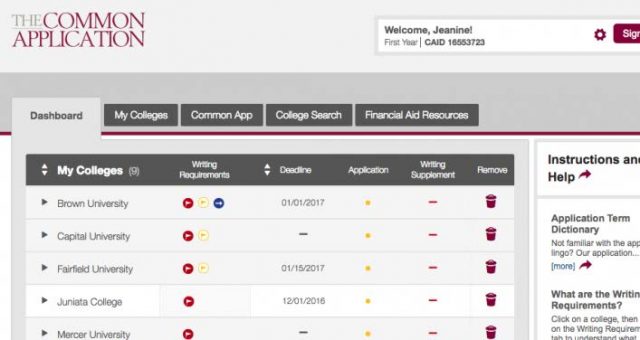Getting you ready forCOLLEGE APPLICATIONS
College Application Platforms
Before you can actually start submitting transcripts, writing essays, and going to interviews, you have to decide which application to send to colleges.
Here are the different options you’ll see as you go through the application process:
Here are the different options you’ll see as you go through the application process:
The Common Application
or Common App, is a single application that is accepted by over 700 different schools. The Common App includes an extracurricular activity list, standardized test scores, official transcripts, letters of recommendation, and a personal statement. Once all the pieces of the Common App have been completed, it can be submitted to any of the member colleges you plan on applying to. These institutions may also require supplemental materials, such as questions about connections to the institutions or extra writing portions.
To use The Common Application:
1. Create an account at https://www.commonapp.org/.
2. Select the institutions you intend to send the Common Application to (you can feel free to edit this later).
3. Fill in all the sections of The Common Application.
4. Complete any “member pages” or “supplemental information” that appear in your Common Application portal based off the institutions you have chosen to apply to.
5. When you are ready to submit, simply click the “Submit” button. Keep in mind that clicking this button will submit the application only to the school you have currently selected. You do not need to send your applications for all schools at once, but bear in mind that you can not go back nor edit any part of your application for a particular school once it has been submitted.
(Source: commonapp.org)
To use The Common Application:
1. Create an account at https://www.commonapp.org/.
2. Select the institutions you intend to send the Common Application to (you can feel free to edit this later).
3. Fill in all the sections of The Common Application.
4. Complete any “member pages” or “supplemental information” that appear in your Common Application portal based off the institutions you have chosen to apply to.
5. When you are ready to submit, simply click the “Submit” button. Keep in mind that clicking this button will submit the application only to the school you have currently selected. You do not need to send your applications for all schools at once, but bear in mind that you can not go back nor edit any part of your application for a particular school once it has been submitted.
(Source: commonapp.org)

The Coalition Application

The Coalition Application is a fairly new application created and accepted by over 100 member schools that make up the Coalition for Access, Affordability, and Success. These institutions pride themselves on having a graduation rate over 70% and offering substantial need-based financial aid. This platform is centered on a “toolkit” that allows students to begin planning for their college application and accumulating materials earlier in their high school career. By focusing on early college planning, the Coalition App is designed to minimize barriers for students with minimal access to college counseling services.
Shared Applications
Shared Applications may exist for a particular set of state schools, in which a single application can be submitted to all schools within a state system. For example, the State University of New York (SUNY) system has a single application which can be submitted to all SUNY schools. Remember, however, that these same schools may also accept another application, as SUNY schools also accept the Common App.
Individual College Applications
Individual College Applications also exist. Many institutions offer their own separate platform for application. While many schools offer their applications through platforms like The Common App or the Coalition App, some schools still require you to submit your application through their website portal. Make sure you are familiar with each school’s application process.
The point of many of these group applications is to minimize the number of times you have to submit the exact same information, so it is important to find the most efficient choice for applying to the colleges of your choice. First, check what applications are accepted by the institutions to which you are applying. Then, if they accept multiple applications, call or email their admissions office to see if they have any preference between different applications. Schools frequently have no preference between different applications, so you can choose the application that the most schools on your list accept. There is plenty to be done during the college application process, so be sure to do your research so you can make this part as easy as possible.

Breaking down the college application
There are many elements that go into a college application, and each school is likely to have their own requirements. Each of these components is a chance to paint a picture for admissions officers about who you are and how you will fit onto their campus. It’s important to review each school’s requirements and speak with your counselor about how to submit these materials.
[bt_bb_menu_item menu_item_title=”Application” menu_item_icon=”” menu_item_description=”Every school you are applying to will require you to fill out a form with general information about you and your family. These questions can range from general questions, like where you went to high school , to more personal questions, such as your family’s income.” menu_item_price=”” menu_item_image=”” color_scheme=”” responsive=”” publish_datetime=”” expiry_datetime=”” el_id=”” el_class=”” el_style=””][/bt_bb_menu_item][bt_bb_menu_item menu_item_title=”Transcript” menu_item_icon=”” menu_item_description=”Your high school transcript, of course, is one of the most important parts of your college application. A transcript is an official record of the classes you have taken and the grades received in each class.” menu_item_price=”” menu_item_image=”” color_scheme=”” responsive=”” publish_datetime=”” expiry_datetime=”” el_id=”” el_class=”” el_style=””][/bt_bb_menu_item][bt_bb_menu_item menu_item_title=”Letters of Recommendation” menu_item_icon=”” menu_item_description=”Some colleges will require you to submit a letter of recommendation, either from a teacher of school counselor, that will help them get a better sense of your character in and outside of the classroom.” menu_item_price=”” menu_item_image=”” color_scheme=”” responsive=”” publish_datetime=”” expiry_datetime=”” el_id=”” el_class=”” el_style=””][/bt_bb_menu_item]
[bt_bb_menu_item menu_item_title=”Test Scores” menu_item_icon=”” menu_item_description=”Most schools will require you to submit scores from standardized college entrance exams such as the SAT or the ACT. These tests are designed to assess a student’s knowledge of skills they’ll need at the college level , such as algebra, grammar, and reading comprehension.” menu_item_price=”” menu_item_image=”” color_scheme=”” responsive=”” publish_datetime=”” expiry_datetime=”” el_id=”” el_class=”” el_style=””][/bt_bb_menu_item][bt_bb_menu_item menu_item_title=”Essays” menu_item_icon=”” menu_item_description=”College application essays are the most important tool for admissions officers to gain insight into who you are and if you’d be a right fit for their campus. In these essays, applicants can express their goals, their values, their voice, and tell their story.” menu_item_price=”” menu_item_image=”” color_scheme=”” responsive=”” publish_datetime=”” expiry_datetime=”” el_id=”” el_class=”” el_style=””][/bt_bb_menu_item]
The Application Process forCREATIVE STUDENTS
If arts have been an integral part of your high school education, you may want to use that experience as part of your college application. Whether applying specifically to schools that allow you to engage in those arts, or hoping to enhance your application to a traditional college by showing your work in the arts, here is advice on making the most of these skills on your application.